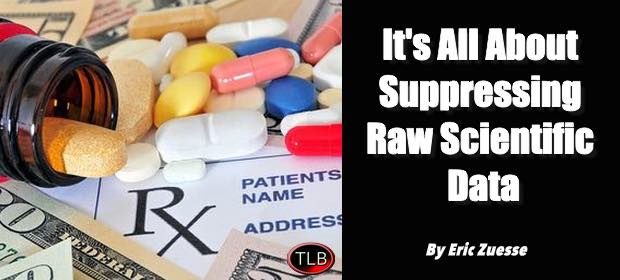
Pam Barker | Director of TLB Europe Reloaded Project
In the article below Eric Zuesse exposes an actual UK case in which a pharmaceutical company withholds critical raw data from scientific reviewers, data which was obtained from necessary clinical trials of a target drug. Withholding this data for a period of time does not,  therefore, permit professional scientific reviewers to apply rigor to their review but renders them effectively a rubber stamp to a drug with ultimately unknown consequences for patients. Further, it gives the pharmaceutical company a sufficient window of time to peddle a dubious drug and make vast profits before the fraud is exposed, very quietly of course.
therefore, permit professional scientific reviewers to apply rigor to their review but renders them effectively a rubber stamp to a drug with ultimately unknown consequences for patients. Further, it gives the pharmaceutical company a sufficient window of time to peddle a dubious drug and make vast profits before the fraud is exposed, very quietly of course.
Readers of Europe Reloaded and its parent site The Liberty Beacon are familiar with our skepticism, indeed contempt for the Big Pharma industry and wholly corrupt government bodies such as the CDC, etc. The evidence abounds. Working in tandem with Robert F. Kennedy Jr.’s site The World Mercury Project, we have exposed much that is similarly corrupt with the vaccine industry, too.
At this juncture, however, I am reminded of a story we published a while back – on the subject of the knowing suppression of raw scientific data to produce entirely false assumptions. It involves the court challenge Canadian climatologist Dr. Tim Ball made to Dr. Michael Mann to produce the raw data upon which the entire global warming scam hinges. Tellingly, Mann had refused, putting him in contempt of the Canadian court: Breaking: Fatal Courtroom Act Ruins Michael ‘Hockey Stick’ Mann. The ramifications of this scam succeeding, of course, are global taxation (the so-called carbon tax) based on fake ‘scientific’ assumptions and thus, ultimately, the creation of global government. Very much rests on the exposure or suppression of raw scientific data.
********
How Current Medicine Is Rigged to Win Government-Approval
ERIC ZUESSE
A libertarian, Pam Barker, called to my attention this scam (which she blames entirely on “regulatory agencies” and not on the entire corrupt socio-political-economic system), and I am here pasting together excerpts of various parts of the evidence in this particular case, so as to provide readers the fastest and most direct access to understanding this systemic scam, in which the drug companies (are legally allowed to) rig our medical system to maximize their profits, at the expense of the public, patients — the broader society. The author of the following article (which article I am slightly rearranging here, to improve clarity) is Dr. Aubrey Blumsohn, who had refused to participate in this scam, and who here reported this scam (which, as I’ll document here, continues unchanged to the present day, to be plaguing the public’s health, and boosting drug-makers’ profits):
http://scientific-misconduct.blogspot.com/2006/08/procter-research-shenanigans-3_07.html
Letter from Richard Eastall ([email protected]), Professor of Bone Metabolism, to Dr. Aubrey Blumsohn, Sr. Lecturer in Metabolic Bone Disease, dated 13 December 2004:
I understand that your major concern [in order to co-sign as an author on a certain ‘scientific’ study] is that you have not had access to the original data. I have checked with Aventis and with other pharmaceutical companies in the field of osteoporosis for their guidelines to publication. They state that they take the approach described in the PhRMA guidelines and that in these guidelines there is not access to the data (other than those from your centre) for investigators.
——————
That’s the key paragraph. Dr. Blumsohn would receive no professional credit from, nor other financial benefits of, his participation in the study unless he would sign off on the study’s findings without having seen all of the data (evidence) that is supposedly the basis of those findings. (The term “ghostwritten” is sometimes used in order to refer to such a study’s actual authorship, but the readers of the study won’t necessarily know that the people who financed the study also actually, in effect, wrote the study.)
PhRMA is the lobby for, and the representative of, the pharmaceutical industry. No link was provided there to “the PhRMA guidelines,” so I web-searched in order to find those “guidelines”, and here they currently are (and this version has been in force since 2009; and the prior version, which pertained to this particular study, was essentially similar on these matters; so there’s been no improvement in this regard):
http://phrma-docs.phrma.org/sites/default/files/pdf/042009_clinical_trial_principles_final_0.pdf
4. Providing Information About Clinical Trials
… As sponsors [the people who are paying for this ‘research’ and who legally will own it], we are responsible for receipt and verification of data from all research sites for the studies we [hire ’scientists’ to] conduct; we ensure the accuracy and integrity of the entire study database, which is owned by the sponsor. …
b. Authorship and Research Contributors.
1. Authors. Consistent with standards of the international committee of Medical Journal editors and major journal guidelines for authorship, anyone who: (1) provides substantial contributions into the conception or design of a study, or data acquisition, or data analysis and interpretation; and (2) writes or revises the manuscript involving important intellectual content; and (3) has final approval of the version to be published, should receive appropriate recognition as an author when the manuscript is published. Conversely, individuals who do not contribute in this manner do not warrant authorship. Authors should meet conditions 1, 2, and 3. …
• all authors, whether from within a sponsoring company or external, will be given the relevant statistical tables, figures, and reports needed to support the planned publication.
2. Contributors. Like other research sponsors, companies sometimes employ staff to help analyze and interpret data, and to produce manuscripts and presentations. Such personnel must act in conjunction with the investigator-author. Their contributions should be recognized appropriately in resulting publications — either as a named author or in acknowledgments, depending on their level of contribution. …
d. Investigator Access to Data and Review of Results. We [PhRMA members: drug-manufacturers] seek to provide investigators with meaningful access to clinical data from the studies in which they participate. Individual investigators in multi-site clinical trials will have their own research participants’ data, and will be provided the randomization code after conclusion of the trial. Sponsors [the drug-manufacturer that has hired a given ‘investigator’] will make a summary of the study results available to the investigators. In addition any investigator who participated in the conduct of a multi-site clinical trial will be able to review relevant statistical tables, figures, and reports for the entire study at the sponsor’s facilities, or other mutually agreeable location. …
Investigators who participated in the conduct of a multi-site clinical trial and are interested in more extensive data displays will be able to review data for the entire study at the sponsor’s facility or other mutually agreeable location in response to a reasonable [as adjudged solely according to the sponsor’s discretion and judgment] scientific inquiry. Investigators who are authors of study-related manuscripts will be given all study data needed to support the publication.
——
I thus now am continuing here with Dr. Blumsohn’s presentation,
http://scientific-misconduct.blogspot.com/2006/08/procter-research-shenanigans-3_07.html:
Procter research shenanigans 3: Research misconduct explained in one letter
Background to the dilemma involving Actonel research in Sheffield is here, here and here. The research involved a secondary endpoint in randomized trials used to demonstrate the efficacy of risedronate (Actonel) for regulatory approval. The company violated the norms of science under whose banner they claim to sell their products.
There were three elements to the problem:
- A pharmaceutical benefactor (Proctor & Gamble) repeatedly refused to provide raw data including randomization codes to academic “collaborators”. Data was required by the academics to verify scientific reports, statistical analyses, meeting abstracts (1,2), and draft publications “ghost written” in their names.
- Data was provided to authors 3 years later, in early 2006, following press exposure. “Fair” analysis of the data would not have yielded findings desired by the sponsor.
- There were multifaceted and intriguing attempts to prevent the problem from being raised or discussed.
A single letter summarizes problem 1: here.
The writer is Professor Richard Eastell, collaborator in this research, and then Research Dean of Sheffield Medical School. It was written after numerous attempts to gain access to data from the company, and after some information had emerged to suggest that the analysis performed by P&G was implausible. A publication based on overlapping data had already appeared in press (Eastell et al., 2003 J. Bone. Miner. Res. 18:1051-6) — the raw data underlying this overlapping paper had also not been disclosed to Sheffield authors (BBC broadcast).
This letter from Professor Eastell was written in response to two letters from myself here and here. Eastell’s “response” (again, here):
- attempts to rationalize why it was appropriate for authors to be refused access to critical raw data
- suggests that the first author (Blumsohn) would be removed even as a coauthor unless prepared to sign a journal declaration in the absence of data
Abstracts underlying intended publications:
• A. Blumsohn, IP Barton, A Chines, R Eastell Relative Contributions Of The Early Changes In Bone Resorption And Later Changes In Hip Bone Mineral Density To The Reduction In Vertebral Fracture Risk With Risedronate. [J Bone Miner Res 2003;18(S2):S157 Abst#SA337
• A. Blumsohn, IP Barton, A Chines, R Eastell. Relationship Of Early Changes In Bone Turnover To The Reduction In Vertebral Fracture Risk With Risedronate – The HIP Study. [J Bone Miner Res 2003;18(S2):S89 Abst#F338
——————
Here is industry-provided information on that drug, Risedronate.
Here is Government-provided information (after-the-fact and too late) regarding the entire class of these drugs. The person posting it is Dr. Blumsohn himself, who then follows up there on the case.
Medicines being allowed onto the market in this way — and the participating ‘researchers’ and their sponsors not being imprisoned for this scam against the public — proves that the government, in fact, doesn’t actually represent the public’s interests, but instead represents the interests of the aristocracy who own and control the corporations.
Such a government is an aristocracy, not really a democracy. The corporate owners run such a country, the public do not, no matter whether or not the Government calls itself a ‘democracy’. It’s an aristocracy, a fascist dictatorship — that’s all. Anyone who calls it a “democracy” is either ignorant or a liar.
The problem isn’t that the regulators exist; it’s that they’re controlled by and serve the corporations they ‘regulate’, instead of controlled by and serving the public. This is a reason why I consider libertarianism to be false. I think that libertarians apply a false theory — in this instance, the theory that regulation should be eliminated, instead of required to be honest and to impose severe penalties upon the participants in frauds like these.
———————————————
Investigative historian Eric Zuesse is the author, most recently, of They’re Not Even Close: The Democratic vs. Republican Economic Records, 1910-2010, and of CHRIST’S VENTRILOQUISTS: The Event that Created Christianity.




